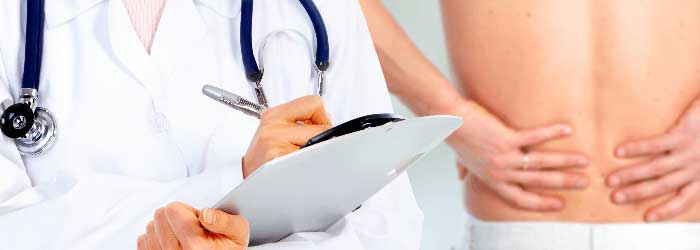Can Scoliosis Cause Back Pain

Can Scoliosis cause back pain? Let’s start by understanding what Scoliosis is… who is the most vulnerable and what causes Scoliosis? Normally, a healthy spine (from a posterior angle) should align vertically in a person’s back, right down the middle and the lateral view the spine curves into three natural curves known as the cervical spine, thoracic spine, and lumbar spine. However, in patients suffering from Scoliosis, the spine will curve to one side or the other creating an abnormal curvature. The degree of the curve itself is what determines the presence of scoliosis. There may be a small or large curvature of the spine, but anything that measures over 10 degrees is considered scoliosis. It is common for doctors to refer to the letters “S” and “C” when describing the shape of the backbone when scoliosis is present.
Early Signs of Scoliosis
Sometimes scoliosis can be difficult to detect, a person with scoliosis will stand differently from someone without it. They may lean slightly to one side, or have uneven hips or shoulders. Sometimes a teacher or parent will notice that a child’s clothes hang unevenly, or that their head appears to not be centered with respect to shoulder symmetry. Talking to a specialist, like Dr. Jones-Quaidoo at Spine Vue, about any concerns and proper evaluation of Scoliosis is your best option if you suspect an abnormal curve of the spine. There are many types of Scoliosis ranging from birth to degenerative, a thorough diagnosis is necessary to find the most effective treatment for this condition.
So, What Causes Scoliosis?
The exact reason for a curved spine isn’t always identifiable. If there is no known cause for scoliosis, it is referred to as “idiopathic.” It is important to remember that genetics can come into play with regards to idiopathic scoliosis. Screening for this condition should be done regularly for all biological family members if a parent or sibling has been diagnosed with this disorder. Scoliosis will be defined as “structural” or “nonstructural”. Structural Scoliosis is a curve of the spine that is permanent. Some reasons for this are:
- Neuromuscular Conditions
- Birth Defects
- Injuries
- Infections
- Tumors
However, some kinds of scoliosis can be traced to a specific cause. Technically, if the spine works as it should, but appears to be curved, it is referred to “nonstructural” scoliosis or functional Scoliosis. One of the reasons for a curved spine which still works normally could be that one leg is longer than the other, another could be spasms which cause tightening in the muscles, resulting in a temporary curvature. With proper treatment, this type of scoliosis may disappear.
Scoliosis and Back Pain
If scoliosis is developed while a baby’s back is forming before birth, it is called Congenital Scoliosis. When there are problems with the tiny vertebrae, the spine can curve in utero. Doctors may diagnose this condition when the baby is born, or they may not discover it until the teen years.
In children or teens, scoliosis is usually not painful. If there is back pain, it is primarily because the curve in the spine is putting pressure on the spinal discs, ligaments, muscles, or nerves, but not due to the curve itself. It is important that any child with Scoliosis whether he/she feels pain or not be seen by a spine specialist regularly. When pain is present, your spine specialist will determine the specific area of pain and set out the most effective treatment solution given the severity and placement of pain.
Even so, it should be noted that many people with idiopathic scoliosis state that they feel their pain is, in fact, due to the curve. While research is not yet conclusive, there are some studies that indicate more back pain is reported by patients who have scoliosis than by patients who do not.
Scoliosis should always be monitored by a qualified professional. It may need to be treated with a brace to stop the progress of the curvature. If there is discomfort, pain management and physical therapy could be prescribed. However, if this does not achieve the desired goal, surgery may be considered. The good news is that surgical procedures have progressed dramatically from years past. Today, surgeons can utilize minimally invasive techniques which provide fewer risks, less scarring and faster recovery.
If you have concerns about Scoliosis and would like a consultation, contact Spine Vue today to research your options, and get on the right path to a healthier you.
